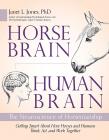Are you using your horse’s brain?

Currently I am reading a book entitled “Horse Brain Human Brain The Neuroscience of Horsemanship” by Janet L. Jones, Ph.D. Jones has taught the neuroscience of perception, language memory and thought. Additionally, she has a successful horse training business.
The main thrust of her book is how similar and more importantly how different our brains are from our horse’s. How we see and perceive the world are so vastly different that it is a wonder that we can accomplish anything with them.
One of the most important things Iearned from this book is how we don’t utilize the horse’s senses to our best ability.
The sense of smell is so more powerful than I ever thought. The horse’s sense of smell is probably the strongest source of perception. How many times has our horse pulled us toward a pile of poop? To them it is their version of Facebook. They can tell the sex, health and social rank of the horse who left it. If it is a mare that left it your horse can tell if she is in season. The other senses are often used in support of the sense of smell. If it smells ok and the vision and hearing seem to support that, then by golly it’s ok.
Eyesight is another example of our differences, human eyes take about 25 minutes to completely adjust to from light to dark, horses on the other hand take roughly 45 minutes. Why does this happen and why is this important? The large size of the iris, which has been constricted down to the smallest circumference possible, just can’t dilate as quickly as ours.
If we are warming up in the bright sunshine, then enter a somewhat poorly lit indoor arena we are asking the horse to perform without clear vision. Since they lack visual acuity and only see vague outlines this can cause shying, bolting or several other behaviors.
How can we help reduce the amount of spooking our horses produce? Small things like stand in the shade after you are warmed up, ask that all the indoor lights be turned on, even painting your poles vibrant yellow or teal (these are the colors horses see best).
For an example of how we see the world differently take a look at this.
https://www.facebook.com/watch/?v=1135019499918691
Another example of our differences is our ability to bypass small changes in the environment, such as the hose being put away in different ways depending upon whether someone with OCD puts it away or someone that just plops it down.
Horses see that small difference and think it is an entirely new hose where we just see it as a hose. This is called Categorical Perception. We have a natural tendency to group things together. If you taste all types of cheese (cheddar, gouda, pepper jack etc.) we group it as just cheese, horses don’t have that ability.
To them each new change to the hose (balled up, stretched out, new color, muddy hose, leaking hose, you get the picture) is a brand-new hose. Once of the reasons this lack of perception is good for them is their poor visual acuity. They can see these minor differences and in doing so they may just stay alive a bit longer.
I’ve asked myself how this knowledge can (plus the other bits of gold in the book) help me be a better equine massage therapist.
For starters I can:
- Take more time when approaching a horse who has just been outside, so they know I am there and approaching
- Allow them to smell me longer and to allow them to smell any tools I may use
- Acknowledge that changes in their environment can add to their stress
- Quiet my movements, slow and apparent rather than quick and furtive
- And finally realize that what I perceive and what they perceive can be two entirely different things.
I believe by making these small changes I can continue to enhance the quality of life for all equines regardless of discipline.
Please visit my website to learn more about me and how I can help you achieve your goals with your horse.
